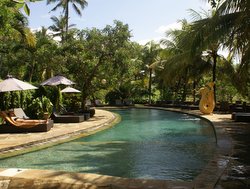Bali
Notes from our trip to Bali in 2012
When you decide on a trip to Bali, for sure your reasons will not include visits to wineries. In fact if you had heard anything about Bali and wine it would have been how expensive wine is; so expensive you would have to start drinking cocktails. And when you look at your first wine list and do the math you will shudder; then you will look to the bottom price range and see only local wines; then you will order a cocktail. But that is a mistake; there is a reasonably priced local white wine to match the Balinese chilli-based dishes - Hatten Aga white.
Accommodation and Restaurants
Because our party had different ideas about a great place to stay we split our time over four different areas; Medewi for surfing, Suraberata (near Salemadag) for a long beach, Ubud for the mountain spirits and Benoa (near Nusa Dua) for water sports.
Bambu House near Medewi Beach

Bambu House with rattan walls

View from Bambu House

Medewi Beach surf
Bambu House is a privately owned two bedroom traditional-style house set amongst rice paddies and fruit and vegetable plots about a kilometre from the beach. If you are looking for a quiet unspoilt place, with easy access to great surf, away from the hustle and bustle of Kuta, reminiscent of Bali thirty years ago before development, then Bambu House is an ideal place to stay. The real plus for us was that the owner’s relations cooked east Javanese cuisine for both breakfast and dinner.
Gaja Mina Beach Resort, Suraberata

Gaja Mina huts and private garden

Gala Mina pool
The hotel near the long beach pictured at the top of this post is the small Gaja Mina Beach Resort It has eleven villas set among their own private gardens. The place is owned by a French expat and the restaurant has a French twist on local specialities. We found it expensive for what it was and so eat most meals in the nearby Balian Beach eateries, the best probably being Bebek Bentutu where we had a whole duck stuffed with Balinese herbs (Rp160,000 for 2 people); bit of a scrawny bird relative to what we are used to in the UK. However the breakfasts of fruit and green pancakes, banana and honey with thick Balinese coffee around the Gaja Mina pool was superb.
One day we hired a car and driver (Rp 500,000) and landed up in Seminyak for cocktails and dinner. Cocktails at KU DE TA watching the sun set was an experience and so was dinner at the Sip Wine Bar where the relative bargain on the wine list was Bilecart-Salmon champagne at about £100.
Bambu Indah, Ubud


Bed in Bambu Indah 'bridal home

Bambu Indah pool

Bambu Indah view
In Ubud we stayed at the fabulous boutique hotel Bambu Indah It also has eleven ‘rooms’ that are antique Javanese teak wood bridal homes together with bamboo common-use structures. It has a stunning view to the west over the gorge of the Ayung river. The grounds are taken up with vegetable beds that provide produce for the kitchen and a superb dark-bottomed swimming pool built like a natural stream. The food was pretty good but Ubud also has some great restaurants.
We visited Mozaic as the culinary highlight of the trip. It has won many awards including being 12th in the The Miele Guide list of Asia’s Top 20 Restaurants 2011/12. We found it fabulous; setting, food and wine list. They had two menu gourmands (Rp 650,000 each). We selected the one based on local ingredients.
Ubud also has a Four Seasons hotel up the road from where we stayed; full of marble and also great views over the Ayung river. Here we had a very pleasant bottle of Otu sauvignon blanc which retails in the UK for less than £10 but here cost Rp 115,000 or about 10 times more expensive. The infused cold towels that we were given when we arrived were very refreshing. Sometimes you just have to pay for the experience.
Aston Bali Resort & Spa, Benoa

Aston pool and hotel from the beach

One of the many water sports at Aston
For the water sports hotel we stayed at the Aston Bali Resort & Spa in Benoa that is built in a Balinese contemporary style with 187 rooms. This a family hotel with the water sports taking place in a large lagoon behind a barrier reef that stretches the length of quite a long beach. It was good for what it was. The real highlight was the Bumbu Bali Restaurant that was two plots down the somewhat narrow and dangerous road.

Rijsttafel at Bumbu Bali

Traditional dancers at Bumbu Bali
Jimbaran Beach warungs. You first select your seafood which is weighed and then grilled over coconut husks. Don’t be tempted by the lobster as it is ridiculously priced at almost £50 when everything else including prawns is reasonably priced.
Hatten Wines
Komplex Pertokoan Dewa Ruci #3, By-pass Ngurah Rai, Kuta, Bali, 80361; Tel. +62 361 767 42; www.hattenwines.com
Hatten Wines pergola vineyard (Courtesy Hatten Wines)
Hatten Wines has over 24.5 hectares of vines in the North East of Bali. This area near Lovina has long been a grape growing area owing to the abundance of sunshine, clear mountain water and rich volcanic soil. After more than a decade of experimentation they selected a black table grape variety of French origin called ‘Alphonse Lavallée’ for their rosé and red wines and another table grape called Belgia for their whites. The vines in North Bali’s vineyards are trained into an overhead trellis called Pergola, where the posts consist of small trees, which are regularly pruned. Besides keeping the workers cool, the pergola system reduces the risk of diseases and sunburn on the grapes, all contributing to a better fruit quality. The tropical climate makes for the unique character of the winemaking in Bali; the evergreen vines produce grapes in 120-day cycles and are constantly harvested. This and the lack of aging potential of their wines means that they are all non-vintage.
The Hatten Wines winery is located close to the main business centre in Sanur. It is a modern, state of the art facility with stainless steel vessels, refrigeration, installation, a horizontal press, 56 large wine tanks, fermenters, a bottling room, filters of various types and an up to date laboratory facility. It has a capacity of bottling 5000 bottles per day.
In addition to making wine from local grapes Hatten Wines also imports grapes in must form from Australia. The very high duties and taxes on wine would appear to makes this somewhat bizarre idea a worthwhile business as they have been joined by a new venture, Cape Discovery, in the business of importing grapes. Some sources quote import tariffs of 280% but our research shows that import duty and excise tax are around Rp75,000 per bottle; anyway the prices in restaurants and hotels are pretty steep.

Hatten Wines cellar door

View from Hatten Wines cellar door
Luckily you don’t have to go to the very North of Bali to taste their wines as they have established their cellar door in Kuta. From the local AGA range we tasted the rosé (Rp 129,000, just below £10) and their dry white, sweetish white and red (Rp 134,000, just above £10).

The culourful labels of Hatten Wines AGA range
The rosé was not bad for a rosé and is their biggest seller; it had a deep pink colour, was fruity and off dry with a citrus finish. The AGA white had a muscat nose and was light and fruity (citrus, grapefruit hints). These wines were both 11% alcohol. The Alexandria (10.5%) was semi-sweet, light and thin. Both these whites have won prizes in wine shows in Singapore and London. The AGA red (11.5%) was more like a dark rosé; it had some tannins but with no oak was light and fresh. All wines had screw-cap closures. These Hatten wines are ubiquitous in Bali restaurants; we invariable drank the AGA white and really enjoyed it with the chili-based Balinese dishes that we went for.
The Two Islands range is made from imported must. It comprises a Chardonnay, Riesling, Shiraz and Cab Merlot blend. Prices ranged from Rp 193,000 to Rp 200,000; around £15. We tasted the Riesling by way of example. It had the typical turpine nose and citrus palate – not bad. These wines are about half the price of equivalent quality imported wines.




